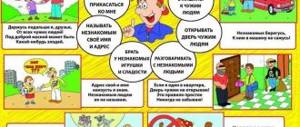All parents are afraid for their children - this is absolutely normal and natural. But in matters concerning their safety, it is very important not to go to extremes. The child must understand that it is impossible to get into the car of a stranger, but he should not live with the fear that every stranger wants to kill him, kidnap him, poison him, rob him. In other words, it is important to instill in him a sufficient understanding of the rules of his own safety, along with trust in the world around him and the comfort of being in it. In this article we will try to understand the key basics of behavior that a child should learn.
Competent behavior with strangers on the street
This is the main group of rules of behavior, since it is on the street that children have the greatest chance of meeting strangers who, one way or another, will make contact with them. It is important to tell your child the following:
- You can't talk to strangers. Communication with strangers on the street is permissible only in the presence of parents, with their consent and under their supervision. Any contact with such people should be through parents.
- You cannot allow strangers to take you away or take you away in a car, under any pretext. Even if the uncle or aunt says that he is doing this at the request of his parents. If mom and dad really ask a person unfamiliar to the child to take him somewhere, they will definitely warn him about this and introduce them in advance. There can be no other situations.
- You should not take any things from strangers, including treats. Even if they seem friendly and the gifts they offer are harmless. If the baby really wants candy or a toy that a stranger offered him, then it’s better to ask mom and dad to buy him the same one.
- You cannot tell strangers your address, phone number, or information about your parents. For whatever reason they asked for this data. Exceptions to the rule are police officers, doctors, and teachers, to whom a child can turn for help in an unforeseen situation.
- You cannot leave school or kindergarten with a stranger. Even if he, again, says that he came for the child at the request of his parents. Parents should warn about such things and introduce the child in advance to the person who will be asked for such a favor.
- The rules of behavior listed above work even if a stranger allows the child to talk on the phone, supposedly with mom or dad, who will confirm his words. You can try calling your parents from your own phone (if the child already has one), but in general, the child must be warned personally about any strangers who will be entrusted to take him or her somewhere.
- You should not agree to offers to spend time with a stranger in any way. For example, go to a movie (or act in it), to an amusement park, to a store. It is better to go to any place and any event with your parents.
- If a suspicious person is walking next to your child, it is better to step aside and let him go ahead. You can go up to any house and wave your hand, looking at the windows, call your relatives by name. If a person does not lag behind, it is worth going out to a crowded place and calling the parents so that they come and take the child home. If you don't have a phone, you can contact the police.
- It is necessary to return home before dark, avoiding deserted wastelands, squares and parks. If suddenly the child cannot return home during daylight hours, you need to move around in as well-lit and crowded places as possible, and best of all, call your family so that they can meet you and take you home.
- If a car slows down next to your child, you need to move away from him (and again: under no circumstances should you get into it, unless it is the parents’ car and one of them is driving).
RULES FOR A CHILD'S SAFE BEHAVIOR WITH STRANGERS. CHILDREN AND STRANGERS. - presentation
RULES FOR A CHILD'S SAFE BEHAVIOR WITH STRANGERS. CHILDREN AND STRANGERS.
The difficult task of raising a child falls on the shoulders of parents in such a way as to protect him from the negative influence of others, as well as the possibility of disappearance. Therefore, it is important not only to teach the child the following rules, but also to establish a sincere and trusting relationship with him. Only in trust and respect will a child listen, understand and comply with what you ask him to do.
Children are often told “you can't talk to strangers” or “stay away from strangers.” We want to share with you four important observations on this matter.
Children often think that a stranger looks dirty, scary and angry, and they have a tendency to believe that a person with a pleasant appearance, neat, well-groomed is not that same stranger. Fact: Many pedophiles deliberately dress beautifully in order to win over children.
Children are confused by rules like “no talking to strangers” when they see their own parents greeting people on the street or talking to a clerk in a store. Children may: Think that if someone has spoken to their parents even once, they are no longer a stranger; Decide that if parents talk to strangers, they (the children) can do it too.
If a child is lost and there is no adult near him whom he could trust, anyone is a stranger to him. How can your child find help if he won't talk to people he doesn't know?
Most people who abduct or rape children are not strangers. They know these kids. Therefore, instead of prohibiting children from talking to strangers, we suggest that you teach your children how to identify dangerous behavior from adults. Try explaining to them four simple rules.
Dangerous Adult Behavior If an adult or older child suggests something to me without asking me, I take a step back, shout “NO!”, run away, and tell the adults. This applies to sweets, animals, offers to work, offers to take pictures, rides, etc.
If an adult or older child asks for my help without asking my permission, I take a step back, shout “NO!”, run away, and tell the adults. This applies to requests to put a letter in the mailbox, help hold the things of a person who has become ill, requests to come to the car and show the way, help with yard work, help look for a missing puppy, etc.
If an adult or older child asks me not to tell anyone about something, I take a step back, scream “NO!”, run away, and tell the adults.
If an adult or older child touches my private parts (those parts of my body that are covered by a swimsuit) or asks me to touch the private parts of another person or myself, I take a step back, shout “NO!”, and run away. and tell the adults.
We recommend reassuring your children that nothing bad will happen if they overdo it and make a mistake! This is part of their learning process. Teach children to identify people they can turn to for help, such as a store clerk or a woman with children.
The main rules established by parents that children must learn. I know my family’s “secret password”, and under no circumstances will I go anywhere with a person who does not know this password.
The main rules established by parents that children must learn. I know that a stranger is any person (male or female) whom I do not personally know.
The main rules established by parents that children must learn. I know not to go anywhere with strangers, and if they approach me, I need to run away.
The main rules established by parents that children must learn. I know that you shouldn't take sweets, food, money or anything else from a stranger.
The main rules established by parents that children must learn. I know not to approach a car with strangers. If a stranger says something to me, I know not to walk up to the car and ask again.
The main rules established by parents that children must learn. I know that you shouldn’t help strangers who ask for directions, help fix a car, or find a lost pet. I know that adults need to turn to other adults to solve these problems. I know that you shouldn't let strangers take pictures of you.
The main rules established by parents that children must learn. If I'm being stalked by a stranger, I know I need to go to a place where there are people and ask for help, instead of hiding in bushes or behind buildings.
The main rules established by parents that children must learn. I know that when I walk down the street, I need to walk at least two arms' length away from a stranger.
The main rules established by parents that children must learn. I know that while I recognize people in certain professions (mailman, delivery guy, pizza delivery guy), they are also considered personal strangers and I should never go anywhere with them without my mom's permission / dad.
How to behave in the elevator and entrance?
Many people live in apartment buildings, which, under unfavorable circumstances, can also become a source of danger for a child (as well as for an adult). The child should be taught the following rules of behavior from childhood:
- Do not enter the elevator with a stranger or someone you barely know. It’s better to let him go ahead and wait until you have the opportunity to take the elevator alone or with friends. In theory, an alternative would be to take the stairs. But if your stairs are quite restless (for example, neighbors may be sitting with cigarettes and a bottle of beer), then it is better to accustom your child to wait for the elevator.
- If a child does end up in an elevator with a stranger, you need to stand facing him or sideways (not your back, i.e. you need to be able to monitor his actions). At the slightest suspicion, you should press the button for the nearest floor and exit. If this fails, you need to click on the button to call the dispatcher.
- You should not enter the entrance if a suspicious stranger is following your child, or open the door to your apartment if a suspicious stranger is in the entrance. It is better to wait until this can be done without any witnesses causing concern.
- While in an apartment, under no circumstances should you open the door to strangers. Whoever they introduce themselves to be: police officers, neighbors, gas service employees. It’s also not worth talking about your parents’ absence at home - it’s better to just ignore them and call an adult just in case.
Basic rules of behavior with strangers
- Let's formulate how to simply and clearly explain to your child the basics of safe behavior with strangers, and at the same time not intimidate or cause anxiety about the fact that every person on the street is a maniac?
— To put it briefly, the main rule of child safety, which every child should know from an early age: never, anywhere, and under any circumstances, go with strangers. This is not cowardice or rudeness, this is normal behavior that can protect a child from violence or kidnapping. By nature, children are careless and trusting, and their attention can be scattered, so the more often you remind your child of the simple rules of safe behavior, the better. Do this regularly.
“Many children still don’t take their parents’ admonitions seriously. This is all like a “theory” for them, a story about someone else. How to reach a child, help him understand that all these conversations are not just a horror story?
— In order for children to better understand safety rules, explain everything using examples and understandable values. First, make it clear that a dangerous person cannot be identified by appearance. Explain to your child that kidnappers or bad people can be very different. They don’t wear black jackets and masks, or brandish knives. This could be a man, a woman, or an elderly person. Recently, attackers often act through children. An unfamiliar boy or girl asks for help and takes the child away from the playground. He is the criminal's accomplice. The same applies to a gaming room in a shopping center, for example.
— What else should a child know about “bad” adults?
— An adult never asks a child for help. It would seem to be an obvious truth, but children, due to their lack of life experience, simply do not think about it. Say this rule of behavior on the street more than once. Don't be afraid to scare your child and cause mistrust of all adults. Well-mannered, adequate adults do not communicate with strange, unfamiliar children; a normal adult will not make requests to children, ask for help, or offer to go somewhere. Even if somewhere a car has hit a dog or an unfortunate kitten is suffering. If you need help, an adult will ask other adults for it! Tell your child this: “If a stranger comes up to you either with a conversation or a request, this is either an ill-mannered adult, or this stranger poses a danger. You need to be careful and collected. There is no need to be polite with such people. Don't talk to a stranger. Leave".
— Attackers are often very inventive, their arsenal of tricks is not limited to pitiful stories about kittens in trouble...
- Yes, unfortunately, this is so. A criminal can easily approach a child on the playground, for example, and say: “Mom is in the hospital, let’s go to her urgently!” Or meet at school: “Dad is late at work today, he asked me to pick you up!” He may even know the child's name, your family's last name. Therefore, the third rule of street safety for a child is: do not trust a stranger who pretends to know you or your family. Strictly prohibit your child from getting into a car with a stranger or unfamiliar person, even a neighbor or a person in a police uniform.
Rules of conduct with strangers for preschoolers
“We cannot be with the child 24 hours a day, and overprotection, as we know, does not bring anything good in the end, but as soon as the child leaves the family and enters society, the risks increase. How to protect your child during this period?
- First, clarify for the child the concepts of familiar and unfamiliar person. Many dangerous situations arise because children do not clearly understand what a “stranger” means, especially if the person called him by name and introduced himself. “Hello, Masha, I’m Anatoly Petrovich.” That's it, it turns out that you already know each other? No.
Invite your child to think like this: “A stranger is someone you don’t know or your parents don’t know.” Even if it is a younger child who knows the names of you and everyone in your family. This is a stranger, an unfamiliar person, you cannot communicate with him, he can be dangerous, he can be an accomplice of a criminal. The following definition: “A person you know is someone you know and your parents know.” Additionally, clarify that by default the child should treat neighbors and distant relatives as strangers, strangers, and cannot leave with them without your permission.
Form a rule with your child - a stranger should not touch you, should not talk to you, unless your parents allow it. Don’t let random people on public transport or on the playground flirt with children, don’t sit them on strangers’ laps, and especially don’t let them hold them in your arms. Correctly explain to the stranger so that the child can hear: you will not allow him to be touched or talked to because you are teaching the rules of safe behavior.
- Most likely, the parent will be mistaken for crazy.
“Or maybe they’ll be rude in return.” A child will probably be upset if the stranger seems attractive to him. Why not play? Explain your behavior to your child like this: “You don’t know this person, I don’t know him, which means he’s a stranger. You can communicate with strangers only with my permission. Now I don’t allow it.” Repeat this every time someone stranger shows increased attention to the child, and in the end he will be left with the thought that there are many people around whom he cannot communicate with without the permission of his parents. This is what we are striving for. Of course, there are many situations when we ourselves communicate with strangers in front of our children. In order not to cause confusion, after each such incident, explain to the children that parents can talk to strangers, but they also behave very carefully.
— And if we are talking about a kindergarten, a section or any other place where we bring the child ourselves, that is, by default we allow him to communicate with the people who are there?
“That’s why not all adults fall into the category of acquaintances.” It is necessary to hand over children personally to the teacher, section coach or club teacher. You cannot take a child away without their knowledge - then he will understand that these particular people are responsible for him, and not just everyone who is in the building, for example. Naturally, in an educational institution, in a sports school, or in a circle, they must clearly know to whom they have the right to transfer the child. And one more thing: sometimes children want adventure, or they are persuaded by other children and run away from the garden. Explain two things to your child: young children should not walk around the city without adults, and you need to be able to say “no” to anyone who tries to involve you in a dangerous situation. The second rule, in principle, is for all time.








